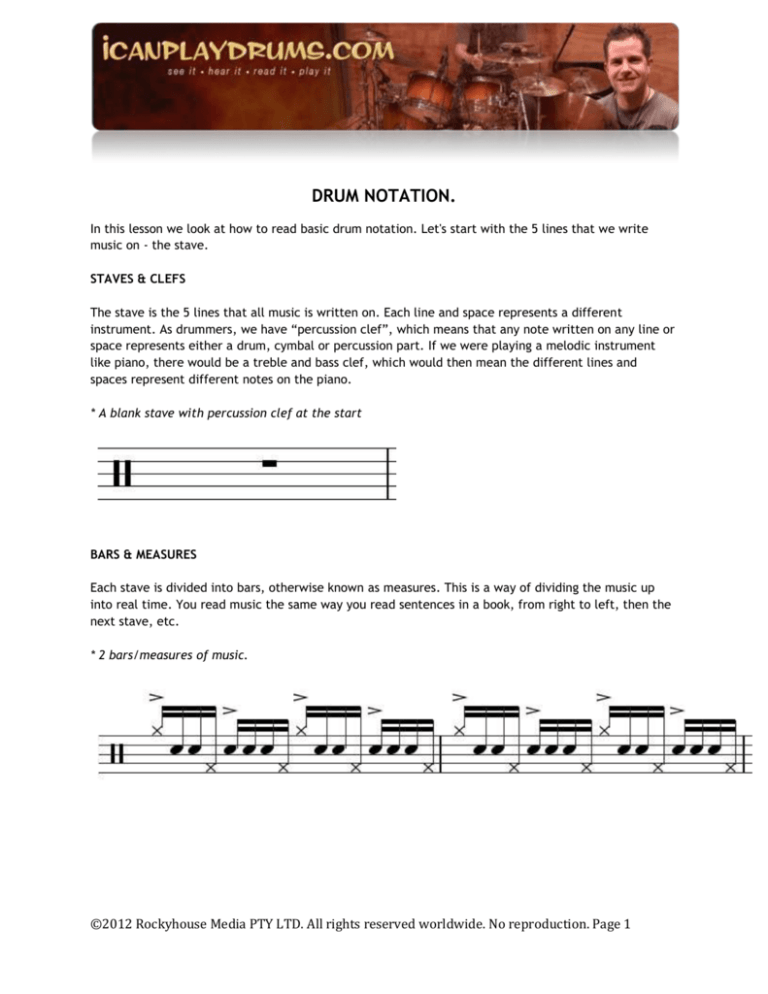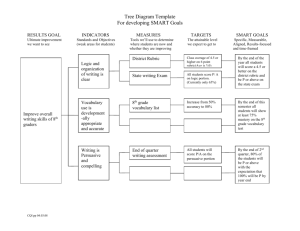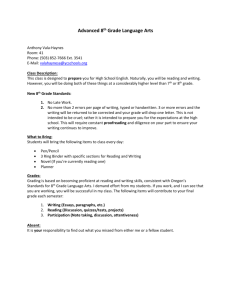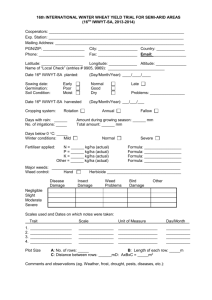
DRUM NOTATION.
In this lesson we look at how to read basic drum notation. Let's start with the 5 lines that we write
music on - the stave.
STAVES & CLEFS
The stave is the 5 lines that all music is written on. Each line and space represents a different
instrument. As drummers, we have “percussion clef”, which means that any note written on any line or
space represents either a drum, cymbal or percussion part. If we were playing a melodic instrument
like piano, there would be a treble and bass clef, which would then mean the different lines and
spaces represent different notes on the piano.
* A blank stave with percussion clef at the start
BARS & MEASURES
Each stave is divided into bars, otherwise known as measures. This is a way of dividing the music up
into real time. You read music the same way you read sentences in a book, from right to left, then the
next stave, etc.
* 2 bars/measures of music.
©2012 Rockyhouse Media PTY LTD. All rights reserved worldwide. No reproduction. Page 1
TIME SIGNATURES
Time signatures divide the music up into bit sized chunks and also represent the counting or feel of the
particular music. There are 2 numbers in a time signature one sitting atop the other. Take for instance
4/4 time..
The top 4 represents that there are 4 notes to be played in every bar, before the new bar starts. The
bottom 4 tells us what kind of beats, the top 4 are. So being a 4, it tells us that there are 4 quarter
notes to be plaed in every bar. This doesn’t mean that you can only play 4 quarter notes in every bar
(which would be ridiculous), it just means that all the rhythms and rests must always equal the
equivalent of 4 quarter notes.
* A 4/4 time signature written on the stave, straight after the percussion clef
If the time signature said 3 / 4...
Then it would mean each bar has only 3 quarter notes in it.
Lets next change the bottom number.
If the time signature said 6 / 8.. is means there are 6 8th notes in each bar, before a new bar must be
written/played.
ODD TIME SIGNATURES
These are certainly less common, but it’s important to understand how they work. You use the exact
same method I used above. Let’s take 15 / 16, which would be written like this..
©2012 Rockyhouse Media PTY LTD. All rights reserved worldwide. No reproduction. Page 2
Once again, you play 15 notes in the bar, because the top number is 15, and what kind of beats are
they? 16th notes. So you must play or write the equivalent (in notes and rests) to 15 x 16th notes.
Usually the bottom number will either be 4 8 or 16, because they are the most common subdivisions.
You will find the bottom number being something like an 11, because there is no such thing as an 11th
note. The top number however can be pretty much anything.
If the time signature said 7/8, we’d be in 7/8 time, which means each bar has 7 8th notes in it.
TIME VALUES
I’ve been talking about different time values above, such as quarter notes, 8th notes, 16th notes and
triplets. What do all these names actually mean? Well they are all different “time values”, and they all
represent different lengths of note – in real time.
If you play a quarter note, it lasts for 1 entire beat. It’s called a quarter note, because in 4/4 time,
which is the most common time signature (otherwise called “common time”), it takes 4 quarter notes
to fill a bar
An 8th note last for half a beat – therefore you play 2 8th notes to every quarter note. You play 8 8th
notes inside a bar of 4/4, hence the name 8th note. An 8th note has 1 flag falling off its stem, or if
grouped together have one beam joining the 8ths.
A 16th note last for one quarter of one beat. It takes 4 16th notes to make up one beat, and therefore
16 16th notes to make up 4 beats. Hence the name 16th notes. A 16th note has 2 flags falling off its
stem, or if playing consecutive 16ths – 2 beams join the notes.
32nd notes are 8 notes inside each beat, and therefore 32 notes inside each bar of 4/4
Triplets are exactly 3 notes per beat. Like regular 8th notes, they either have 1 flag falling off their
stem, or, if grouped together, have one beam joining them all together.
Sextuplets, otherwise known as 32nd note triplets, are 6 even notes per beat, so twice as fast as
triplets. Like 32nd notes, they have 2 flags falling of their stem, or 2 beams joining multiple sextuplets.
RESTS
With time values we can write our note lengths, but if we want to notate silence, we must use rests.
Each time value has its “equivalent rest”. So for example a quarter note, which last for 1 beat, has a
rest that also lasts one beat. Both are pictured below..
©2012 Rockyhouse Media PTY LTD. All rights reserved worldwide. No reproduction. Page 3
So once again, each note has an equivalent rest, which is the same time value as the note, but in
silence. Bars of time can consist of both notes and their rests, and must add up to the total of the time
signature.
NOTE HEADS
As you know the different lines and spaces on the stave represent different drums/cymbals, in
percussion clef. Another way of indicating a special or unusual drum/cymbal is to use a different note
head. The most common note head of course is just a regular black dot, but quite often (when
indicating percussion and effects) other note heads are used, like squares, X’s, diamonds etc..
FLAGS
To indicate a note or rests time value, you write one2, 3, or 4 flags falling off the note.
A quarter note has no flag falling off its stem. An 8th note has 1 flag falling off its stem. A 16th note
has 2 flags falling of its stem. A 32nd note has 3 flags falling off its stem..
* An 8th note with its flag..
BEAMS
When you have multiple notes next to each other you join them by beams rather than writing out flags
off each note. For example if you have 4 16th notes in a row (which each have 2 flags), then instead of
writing them like this..
©2012 Rockyhouse Media PTY LTD. All rights reserved worldwide. No reproduction. Page 4
..you just join them all with 2 beams. 2 beams, because each note has 2 stems..
COMBINATION RHYTHMS
You can also use beams across notes of different time values. Say you have 1 8th note followed by 2
16th notes. Then instead of writing flags like this..
You write a single beam across the 8th notes (because an 8th note only has 1 flag) and a double beam
across the 16th notes (because 16th notes have 2 flags)..
©2012 Rockyhouse Media PTY LTD. All rights reserved worldwide. No reproduction. Page 5
DYNAMIC MARKINGS
We use dynamic markings to indicate the volume that a passage of music should be played at. Here are
the markings and their names from very soft through to very loud.
ppp
Pianississimo
Very very soft
pp
Pianissimo
Very soft
p
Piano
Soft
mp
Mezzo-piano
Moderately soft
mf
Mezzo-forte
Moderately loud
f
Forte
Loud
ff
Fortissimo
Very loud
fff
Fortississimo
Turn your amp up to 11, and watch at everyone get very annoyed.
GRADUAL DYNAMIC MARKINGS
These markings indicate that you should gradually get louder or softer over the piece of music that
they are written across (however long or short it may be).
1) Crescendo – gradually get louder
2) Decrescendo – gradually get softer
©2012 Rockyhouse Media PTY LTD. All rights reserved worldwide. No reproduction. Page 6
DOTTED NOTES
Sometime you will see a dot after a note, like this..
If you see a note with a dot after it, it means the time value of that note is 1 ½ times its original value.
So above we have a quarter note which is worth 1 full beat. Now that it has a dot after it, it’s worth 1
and a half beats (which is also the same as 3 8th notes). This means that the next note or rest that
comes after it, cannot be written until beat 1+
©2012 Rockyhouse Media PTY LTD. All rights reserved worldwide. No reproduction. Page 7







